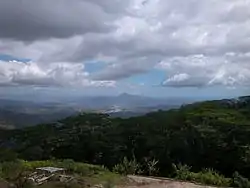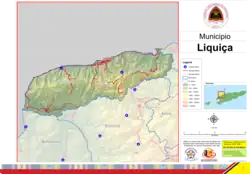Liquiçá Municipality
Liquiçá (Portuguese: Município Liquiçá, Tetum: Munisípiu Likisá) is one of the municipalities (formerly districts) of East Timor. Its capital is also called Liquiçá.
Liquiçá | |
|---|---|
| |
 Fazenda Algarve in Liquiçá | |
 Official map | |
 | |
OpenStreetMap | |
| Coordinates: 8°41′S 125°12′E | |
| Country | |
| Capital | Liquiçá |
| Administrative posts | |
| Area | |
| • Total | 559.9 km2 (216.2 sq mi) |
| • Rank | 12th |
| Population (2015 census) | |
| • Total | 71,927 |
| • Rank | 8th |
| • Density | 130/km2 (330/sq mi) |
| • Rank | 3rd |
| Households (2015 census) | |
| • Total | 11,885 |
| • Rank | 10th |
| Time zone | UTC+09:00 (TLT) |
| ISO 3166 code | TL-LI |
| HDI (2017) | 0.636[1] medium · 2nd |
| Website | Liquiçá Municipality |
Etymology
The English language name of the municipality has been said to be a Portuguese approximation of the old name Liku Saen, which means 'python' in the local Tokodede language, or the corresponding portmanteau Likusaen.[2][3]
Another theory points to the Tokodede expression Likis Aá, meaning 'motion' or 'change', referring to an incident during the founding of the city of Vila de Liquiçá. After the Portuguese had chosen the settlement site, people started clearing the forest there and turning it into an open space. The Portuguese then asked the local people to tell them the name of the area. The local people did not understand the question, and so the Portuguese tried to communicate with gestures by moving their hands back and forth. The local people then responded with the expression Likis Aá, that is, 'moving' or 'changing'.[4]
It has also been asserted that the Portuguese version of the name may also be a "... form of cultural and mind de-colonization ..." [sic - colonization] of the local name that changes the indigenous cultural meanings and history.[3]
Geography
Liquiçá municipality is situated on the northern coast of East Timor, and borders the municipalities of Dili (containing the national capital) to the east, Aileu to the Southeast, Ermera to the south, and Bobonaro to the southwest. To the northwest lies the Savu Sea. The municipality has a population of 73,027 (Census 2010) and an area of 549 km2. The borders of the municipality are identical to those of the district of the same name in Portuguese Timor. Its administrative posts are Bazartete, Liquiçá and Maubara.
Widely known as a beautiful location, it has a breath-taking view of the Ombai Strait, which is most visible as you drive into Liquiçá from Dili, rounding the last mountain curve before descending into the valley. The beaches are rocky, as are most beaches on East Timor, but nonetheless beautiful. The river that flows down to the sea from the mountains is dry, except during the monsoon season. During this time, the main road washes out several times, and is repaired each time by the local population. The only downside to its beauty is the large population of mosquitoes which carry both the deadly diseases malaria and dengue fever.
History
.jpg.webp)
During the Portuguese colonisation of eastern Timor, the Maubara kingdom, in the west of today's Liquiçá municipality, was taken by the Netherlands in 1667, while surrounding territories felt under Portuguese domination. The Maubara Dutch fortification near the beach is well preserved and still has the original cannon that once overlooked the bay. Later, Portugal negotiated with the Netherlands in 1859 and exchanged Maubara for Flores Island in 1861, which was occupied by the Portuguese at that time.
During the Indonesian occupation, the Indonesian government did construct many buildings in Liquiçá, but after the referendum of 1999 and during the militia's campaign almost everything was destroyed. Most notably, many East Timorese were murdered during the Liquiçá Church Massacre of April 1999. Maubara is the location where the dreaded militia group Besi Merah Putih was first formed.[5] In September 1999 an American police officer serving with the International Police was shot (though not fatally) by pro-Indonesian forces while the UN was evacuating Liquiçá.[5]
From September through November 1999, life came back to Liquiçá, as UN Peace Keeping Forces from Portugal set up a base in Maubara, and the International Police set up its headquarters in downtown Liquiçá. Originally, there were 14 International Police assigned to Liquiçá, representing Sweden, Canada, Great Britain, Ghana, Malaysia, and the United States. It was in Liquiçá that the first International Police officer for the East Timor mission died, as a result of contracting dengue fever; he was from Ghana. During this period, the International Police occupied the very same church compound location where the Liquiçá Church Massacre had played out. The peacekeeper military element for Liquiçá were Portuguese Marines. Liquica was also the main base of operations for the UNTAET Crime Scene Detachment.
Administrative posts
The municipality's administrative posts (formerly sub-districts) are:[6]
The administrative posts are divided into 23 sucos ("villages") in total.
Demographics
In addition to the national official languages of Tetum and Portuguese, nearly all of the inhabitants of Liquiçá speak the Malayo-Polynesian language Tocodede.
Places of interest
Liquiçá has beautiful beaches (although no white sands) that are very attractive for tourism. Liquiçá also has coffee plantations and some minerals such as gold. Several diving spots scatter along the coast.
Infrastructure
During the Portuguese occupation, there were very few buildings other than the traditional huts used by local East Timorese. Most of the buildings were constructed during the Indonesian occupation, but most of them were destroyed during the militia riots and violent onslaughts following and leading up to the referendum in 1999. Some of the buildings that still remain intact are the Portuguese buildings. Many of the Indonesian buildings were repairable. The construction and design is a traditional Indonesian style, which is both out dated, yet artistic and creative.
References
Notes
- "Sub-national HDI - Area Database - Global Data Lab". hdi.globaldatalab.org. Retrieved 13 September 2018.
- Hull, Geoffrey (June 2006). "The placenames of East Timor" (PDF). Placenames Australia: Newsletter of the Australian National Placenames Survey: 6–7, at 7. Archived (PDF) from the original on 13 July 2018. Retrieved 25 April 2022.
- "The Real Political and Cultural Meaning and Short History of Koba Lima and Suai". Suai Media Space. Retrieved 26 April 2022.
- "Perfil: 2. Toponímia" [Profile: 2. Toponymy]. Liquiçá Municipality (in Tetum). Retrieved 18 July 2022.
- "Source". 28 May 2006. Archived from the original on 28 May 2006.
- Gunn, Geoffrey C (2011). Historical Dictionary of East Timor. Lanham, Maryland: Scarecrow Press. p. 120. ISBN 9780810867543.
Bibliography
- Sarmento, Eugénio; Miranda, Flávio; Oliveira, Nuno Vasco, eds. (2013). Património Arquitectónico de Origem Portuguesa de Liquiçá / Patrimóniu Arquitetóniku Origem Portugueza Liquiçá nian / Architectural Heritage of Portuguese Origins of Liquiçá (in Portuguese, Tetum, and English). Dili: Secretária de Estado da Arte e Cultura. ISBN 9727572252. Retrieved 26 October 2018.
{{cite book}}: CS1 maint: ignored ISBN errors (link) - Profile of Liquica District (PDF) (Report). Office of Local Government and Development, Liquiça District. January 2002. Archived from the original (PDF) on 28 March 2009. Retrieved 27 February 2022.
- Munisipio Liquiçá: Planu Estartejiku Desenvolvimentu Munisipal [Liquiçá Municipality: Municipal Strategic Development Plan] (Report) (in Tetum). Ministry of State Administration (East Timor) / Administration of Liquiçá Municipality. 2015. Retrieved 18 July 2022.
- Perfil Distritu Liquiçá [Liquiçá District Profile] (PDF) (Report) (in Tetum). 2012. Archived (PDF) from the original on 3 March 2014. Retrieved 18 July 2022.
External links
![]() Media related to Liquiçá (Municipality) at Wikimedia Commons
Media related to Liquiçá (Municipality) at Wikimedia Commons
- Liquiçá Municipality – official site (in Tetum with some content in English)
- Liquiçá Municipality – information page on Ministry of State Administration site (in Portuguese and Tetum)
-APiazza.JPG.webp)